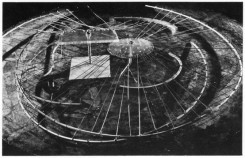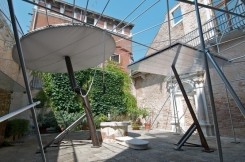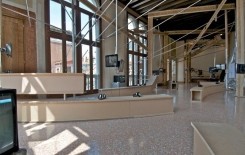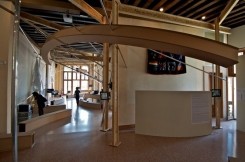Image

AERNOUT MIK (artist, the Netherlands)
Exhibition Architecture (After Constant’s Design for a Gypsy Camp)
Although known mainly for his video installations, artist Aernout Mik’s work encompasses an entanglement of the moving image with elements of performance, architecture, and social commentary. The latter two come distinctively to the fore with his contribution to the Roma Pavilion, which takes the form of an artistic reinterpretation of Design for a Gypsy Camp (1956–1958) by Dutch artist and architecture visionary Constant (1920–2005).
Constant’s proposition for a “nomadic camp”—which came into being as a reaction to the discrimination (and expulsion) of Roma families in the Italian city of Alba—was never realized, yet thinking about the Roma people’s way of life as exemplary for the majority society became one of the foundations of Constant’s practice (influencing his most famous work New Babylon (1956–1974), for example). Mik enters into a polemic with the utopian nature of Design for a Gypsy Camp, and tests its potentials when this unrealized project becomes inhabited, in a sense, albeit not by an itinerant Roma community, but rather by works of art, discourses, and their publics. Experimenting with an open system of mobile walls, spiraling wires, and semi-circular forms, and blurring the border between “inside” and “out” by letting his architectural intervention “cut” through the walls of Palazzo Zorzi, Mik creates a generous multifunctional space of hospitality while maintaining core ideas of contingency, improvisation, and provisionality in dynamic tension. (Maria Hlavajova)
Website Call The Witnes




AERNOUT MIK (born 1962) is an artist whose work emerges from the entanglements of video installation, performance, and architectural interventions. His practice examines the hegemonic consensus in contemporary (western) societies, and by unmasking and magnifying certain aspects of human behavior—mainly within a collective, community setting—Mik posits the possibility of a radical and pervasive change. A major retrospective exhibition of his work, Aernout Mik. Communitas, premiered at Musée Le Jeu de Paume, Paris in spring 2011 and travels to Museum Folkwang, Essen, 2011, and the Stedelijk Museum, Amsterdam, 2012 (catalog forthcoming). Other recent exhibitions include: Aernout Mik, Museum of Modern Art, New York, 2009; Aernout Mik. Raw Footage, Moderna galerija, Ljubljana, 2008; Citizens and Subjects: Aernout Mik, Dutch Pavilion, 52nd Venice Biennale, Venice, 2007; Shifting, Shifting, Camden Arts Centre, London, 2007; and Raw Footage/Scapegoats, BAK, basis voor actuele kunst, Utrecht, 2006. Mik lives and works in Amsterdam.